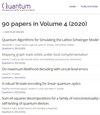通过多体相关测量对费米子态进行分类
IF 5.1
2区 物理与天体物理
Q1 PHYSICS, MULTIDISCIPLINARY
引用次数: 0
摘要
理解多体系统中量子相关的结构是其计算处理的关键。对于费米子系统,相关可以定义为偏离斯莱特行列式状态。费米子相关和高效计算物理方法之间的联系正在积极研究,但仍然模糊不清。我们在数学上建立这种联系方面取得了进展。特别是,我们发现了相对于k -费米子相关的状态的严格分类,这允许计算物理解释。相关关系是通过测量$\omega_k$来捕获的,这是一个$k$-费米子简化密度矩阵的函数,我们称之为扭曲纯度。对于给定的$k$,条件$\omega_k=0$将该状态置于相关状态$G_k$的一类中。集合$G_k$嵌套在$k$中,并且Slater行列式对应于$k = 1$。类$G_{k=O(1)}$被证明是物理相关的,因为$\omega_k$对于截断的构型相互作用态、Slater行列式周围的摄动序列和1D Hubbard模型的一些非摄动特征态会消失或接近消失。对于每一个$k = O(1)$,我们给出了一个具有多项式个数参数的显式ansatz,它涵盖了$G_k$中的所有状态。讨论了该分析的潜在应用及其与耦合簇波函数的联系。本文章由计算机程序翻译,如有差异,请以英文原文为准。
Classifying fermionic states via many-body correlation measures
Understanding the structure of quantum correlations in a many-body system is key to its computational treatment. For fermionic systems, correlations can be defined as deviations from Slater determinant states. The link between fermionic correlations and efficient computational physics methods is actively studied but remains ambiguous. We make progress in establishing this connection mathematically. In particular, we find a rigorous classification of states relative to $k$-fermion correlations, which admits a computational physics interpretation. Correlations are captured by a measure $\omega_k$, a function of $k$-fermion reduced density matrix that we call twisted purity. A condition $\omega_k=0$ for a given $k$ puts the state in a class $G_k$ of correlated states. Sets $G_k$ are nested in $k$, and Slater determinants correspond to $k = 1$. Classes $G_{k=O(1)}$ are shown to be physically relevant, as $\omega_k$ vanishes or nearly vanishes for truncated configuration-interaction states, perturbation series around Slater determinants, and some nonperturbative eigenstates of the 1D Hubbard model. For each $k = O(1)$, we give an explicit ansatz with a polynomial number of parameters that covers all states in $G_k$. Potential applications of this ansatz and its connections to the coupled-cluster wavefunction are discussed.
求助全文
通过发布文献求助,成功后即可免费获取论文全文。
去求助
来源期刊

Quantum
Physics and Astronomy-Physics and Astronomy (miscellaneous)
CiteScore
9.20
自引率
10.90%
发文量
241
审稿时长
16 weeks
期刊介绍:
Quantum is an open-access peer-reviewed journal for quantum science and related fields. Quantum is non-profit and community-run: an effort by researchers and for researchers to make science more open and publishing more transparent and efficient.
 求助内容:
求助内容: 应助结果提醒方式:
应助结果提醒方式:


